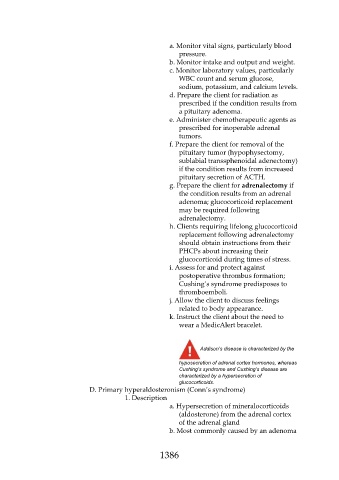Page 1386 - Saunders Comprehensive Review For NCLEX-RN
P. 1386
a. Monitor vital signs, particularly blood
pressure.
b. Monitor intake and output and weight.
c. Monitor laboratory values, particularly
WBC count and serum glucose,
sodium, potassium, and calcium levels.
d. Prepare the client for radiation as
prescribed if the condition results from
a pituitary adenoma.
e. Administer chemotherapeutic agents as
prescribed for inoperable adrenal
tumors.
f. Prepare the client for removal of the
pituitary tumor (hypophysectomy,
sublabial transsphenoidal adenectomy)
if the condition results from increased
pituitary secretion of ACTH.
g. Prepare the client for adrenalectomy if
the condition results from an adrenal
adenoma; glucocorticoid replacement
may be required following
adrenalectomy.
h. Clients requiring lifelong glucocorticoid
replacement following adrenalectomy
should obtain instructions from their
PHCPs about increasing their
glucocorticoid during times of stress.
i. Assess for and protect against
postoperative thrombus formation;
Cushing’s syndrome predisposes to
thromboemboli.
j. Allow the client to discuss feelings
related to body appearance.
k. Instruct the client about the need to
wear a MedicAlert bracelet.
Addison’s disease is characterized by the
hyposecretion of adrenal cortex hormones, whereas
Cushing’s syndrome and Cushing’s disease are
characterized by a hypersecretion of
glucocorticoids.
D. Primary hyperaldosteronism (Conn’s syndrome)
1. Description
a. Hypersecretion of mineralocorticoids
(aldosterone) from the adrenal cortex
of the adrenal gland
b. Most commonly caused by an adenoma
1386

